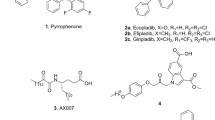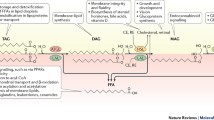Abstract
We have undertaken a study to characterize the lipolytic pathway responsible for the generation of free fatty acids (FFA) during Fas/CD95-induced apoptosis in Jurkat cells. It was initially shown that the cellular lipid fraction that suffered the major quantitative decrease during Fas-induced apoptosis was that of phosphatidylcholine (PC). In addition, the secretion of palmitic acid-derived FFA was largely prevented by D609, an inhibitor of PC-specific phospholipase C (PC-PLC) and also by the diacylglycerol lipase (DAGL) inhibitor RHC-80267, suggesting that the secretion of these FFA during Fas-induced apoptosis is mediated by the generation of DAG by a PC-PLC activity and, sequentially, by a 1-DAGL activity which generates the FFA from its sn-1 position. The endocannabinoid 2-arachidonoyl glycerol (2-AG) should be generated as a sub-product of this pathway, but it did not accumulate inside the cells nor was secreted into the supernatant. Interestingly, the complete inhibition of free AA secretion during Fas-induced apoptosis was only achieved by using the AA trifluoromethylketone, which not only inhibits all types of phospholipase-A2 (PLA2) activities, but also the described lytic activities on 2-AG. Using a combination of RHC-80267 and the iPLA2-specific inhibitor bromoenol lactone, it was shown that the DAGL pathway also cooperates with iPLA2 in the generation of free arachidonate.
Similar content being viewed by others
Abbreviations
- AA:
-
arachidonic acid
- AAtfmk:
-
arachidonoyl trifluoromethylketone
- 2-AG:
-
2-arachidonoyl-glycerol
- BEL:
-
bromoenol lactone
- CH:
-
cholesterol
- CE:
-
cholesteryl esters
- Cer:
-
ceramide
- CL:
-
cardiolipin
- c-PLA2:
-
cytosolic phospholipase-A2
- DAG:
-
diacylglycerol
- DAGL:
-
diacylglycerol lipase
- D609:
-
Tricyclodecan-9-yl xanthate potassium
- FAAH:
-
fatty acid amide hydrolase
- FFA:
-
free fatty acids
- i-PLA2:
-
Ca++-independent phospholipase-A2
- LPC:
-
lysophosphatidylcholine
- mAb:
-
monoclonal antibody
- MAG:
-
monoacylglycerol
- MAGL:
-
monoacylglycerol lipase
- MTT:
-
3-[4,5-dimethylthiazol-2-yl]-2,5-diphenyl-tetrazolium bromide
- PA:
-
palmitic acid
- PC:
-
phosphatidylcholine
- PC-PLC:
-
phosphatidylcholine-specific phospholipase C
- PE:
-
phosphatidylethanolamine
- PI:
-
phosphatidylinositol
- PL:
-
phospholipids
- PS:
-
phosphatidylserine
- RHC:
-
1,6-bis (cyclohexyloximinocarbonylamino) hexane
- SM:
-
sphingomyelin
- SMase:
-
sphingomyelinase
- TAG:
-
triacylglycerol
References
Neale ML, Fiera RA, Matthews, N. Involvement of phospholipase A2 activation in tumour cell killing by tumour necrosis factor. Immunology 1988; 64: 81–85.
Atsumi GI, Tajima M, Hadano A, Nakatani Y, Murakami M, Kudo I. Fas-induced arachidonic acid release is mediated by Ca2+-independent, but not cytosolic phospholipase A2, which undergoes protolytic inactivation. J Biol Chem 1998; 273: 13870–13877.
Enari M, Hug H, Hayakawa M, Ito F, Nishimura Y, Nagata S. Different apoptotic pathways by Fas and the tumor-necrosis-factor receptor. Cytosolic phospholipase A2 is not involved in Fas-mediated apoptosis. Eur J Biochem 1996; 236: 533–538.
Koren HS, Ferber E, Fischer H. Changes in phospholipid metabolism of a tumor target cell during a cell-mediated cytotoxic reaction. Biochim Biophys Acta 1971; 231: 520–526.
Richieri GV, Kleinfeld AM. Free fatty acids are produced in and secreted from target cells very early in cytotoxic T lymphocyte-mediated killing. J Immunol 1991; 147: 2809–2815.
Brekke OL, Sagen E, Bjerve KS. Specificity of endogenous fatty acid release during TNF-induced apoptosis in WEHI 164 fibrosarcoma cells. J Lipid Res 1999; 40: 2223–2233.
Iturralde M, Gamen S, Pardo, et al. Saturated free fatty acids release and intracellular ceramide generation during apoptosis induction are closely related processes. Biochim Biophys Acta 2003; 1634: 40–51.
Nagata S. Apoptosis by death factor. Cell 1997; 88: 355–365.
Nicholson DW, Thornberry NA. Caspases : Killer proteases. Trends Biochem Sci 1997; 22: 299–306.
Cifone MG, De Maria R, Roncaioli, et al. Apoptotic signaling through CD95 (Fas/Apo-1) activates an acidic sphingomyelinase. J Exp Med 1993; 177: 1547–1552.
Gamen S, Marzo I, Anel A, Piñeiro A, Naval J. CPP32 inhibition prevents Fas-induced ceramide generation and apoptosis in human cells. FEBS Lett 1996; 390: 233–237.
Tepper AD, Boesen-de Cock JGR, de Vries E, Borst J, van Blitterswijk WJ. CD95/Fas-induced ceramide formation proceeds with slow kinetics and is not blocked by caspase-3/CPP32 inhibition. J Biol Chem 1997; 272: 24308–24312.
Tepper AD, de Vries E, van Blitterswijk WJ, Borst J. Ordering of ceramide formation, caspase activation, and mitochondrial changes during CD95- and DNA damage-induced apoptosis. J. Clin Invest 1999; 103: 971–978.
Tepper AD, Ruurs P, Wiedmer T, Sims PJ, Borst J, van Blitterswijk WJ. Sphingomyelin hydrolysis to ceramide during the execution phase of apoptosis results from phospholipid scrambling and alters cell-surface morphology. J Cell Biol 2000; 150: 155–164.
Savill J, Fadok V. Corpse clearance defines the meaning of cell death. Nature 2000; 407: 784–788.
Cauwels A, Janssen B, Wayetens A, Cuvelier C, Brouckaert P. Caspase inhibition causes hyperacute TNF-induced shock via oxidative stress and PLA2. Nature Immunol 2003; 4: 387–393.
Adam-Klages S, Schwander R, Lüschen S, Ussat S, Kreder D, Krönke M. Caspase-mediated inhibition of human cytosolic phospholipase A2 during apoptosis. J Immunol 1998; 161: 5687–5694.
Atsumi GI, Murakami M, Kojima K, Hadano A, Tajima M, Kudo I. Distinct roles of two intracellular phospholipase A2 in fatty acid release in the cell death pathway. J Biol Chem 2000; 275: 18248–18258.
Lauber K, Bohn E, Kröber, et al. Apoptotic cells induce migration of phagocytic cells induce migration of phagocytes via caspase-3-mediated release of a lipid attraction signal. Cell 2003; 113: 717–730.
Müller-Decker K. Interruption of TPA-induced signals by an antiviral and antitumoral xanthate compound : Inhibition of a phospholipase C-type reaction. Biochem Biophys Res Commun 1989; 162: 198–205.
Schütze S, Potthoff K, Machleidt T, Berkovic D, Wiegmann K, Krönke M. TNF activates NF-κB by phosphatidylcholine-specific phospholipase C-induced “acidic” sphingomyelin breakdown. Cell 1992; 71: 765–776.
Stella N, Schweitzer P, Piomelli D. A second endogenous cannabinoid that modulates long-term potentiation. Nature 1997; 388: 773–778.
Sutherland C, Amin D. Relative activities of rat and dog platelet phospholipase A2 and diglyceride lipase. Selective inhibition of diglyceride lipase by RHC 80267. J Biol Chem 1982; 257: 14006–14010.
Ackermann EJ, Conde-Frieboes K, Dennis EA. Inhibition of macrophage Ca2+-independent phospholipase A2 by bromoenol lactone and trifluoromethyl ketones. J Biol Chem 1995; 270: 445–450.
Di Marzo V, Bisogno T, De Petrocellis, et al. Biosynthesis and inactivation of the endocannabinoid 2-arachidonoylglycerol in circulating and tumoral macrophages. Eur J Biochem 1999; 264: 258–267.
Cabanillas JA, Pacheco-Castro A, Zapata, et al. T cell transformation with Herpesvirus saimiri : A tool for primary immunodeficiencies research. Recent Res Devel Immunology 2002; 4: 382–394.
Alley MC, Scudiero DA, Monks, et al. Sensibility of drug screening with panels of human tumor cell lines using microculture tetrazolium assay. Cancer Res 1988; 46: 589–601.
Anel A, Buferne M, Boyer C, Schmitt-Verhulst AM, Golstein P. T cell receptor-induced Fas ligand expression in cytotoxic T lymphocyte clones is blocked by protein tyrosine kinase inhibitors and cyclosporin. A Eur J Immunol 1994; 24: 2469–2476.
Pardo J, Balkow S, Anel A, Simon MM. The differential contribution of granzyme A and granzyme B in CTL-mediated apoptosis is determined by the quality of target cells. Eur J Immunol 2002; 32: 1980–1985.
Anel A, Naval J, Desportes P, Gonzalez B, Uriel J, Piñeiro A. Increased cytotoxicity of polyunsaturated fatty acids on human tumoral B and T-cell lines compared with normal lymphocytes. Leukemia 1992; 6: 680–688.
Jacobsson SO, Wallin T, Fowler CJ. Inhibition of Rat C6 Glioma Cell Proliferation by Endogenous and Synthetic Cannabinoids. Relative Involvement of Cannabinoid and Vanilloid Receptors. J Pharmacol Exp Ther 2001; 299: 951–959.
Anel A, Naval J, González, et al. Fatty acid metabolism in human lymphocytes. I. Time-course changes in fatty acid composition and membrane fluidity during blastic transformation of peripheral blood lymphocytes. Biochim Biophys Acta 1990; 1044: 323–331.
Zhang J, Driscoll TA, Hannun YA, Obeid LM. Regulation of membrane release in apoptosis. Biochem J 1998; 334: 479–485.
Anel A, Gamen S, Alava MA, Schmitt-Verhulst AM, Piñeiro A, Naval J. Inhibition of CPP32-like proteases prevents granzyme B- and Fas-, but not granzyme A-based cytotoxicity exerted by CTL clones. J Immunol 1997; 158: 1999–2006.
Bisogno T, Sepe N, Melck D, Maurelli S, De Petrocellis L, Di Marzo V. Biosynthesis, release and degradation of the novel endogenous cannabimimetic metabolite 2-arachidonoylglycerol in mouse neuroblastoma cells. Biochem J 1997; 322: 671–677.
Di Marzo V, De Petrocellis L, Sugiura T, Waku K. Potential Biosynthetic Connections between the Two Cannabimimetic Eicosanoids, Anandamide and 2-Arachidonoyl-Glycerol, in Mouse Neuroblastoma Cells. Biochem Biophys Res Commun 1996; 227: 281–288.
Bisogno T, Maccarrone M, De Petrocellis, et al. The uptake by cells of 2-arachidonoylglycerol, an endogenous agonist of cannabinoid receptors. Eur J Biochem 2001; 268: 1982–1989.
Smani T, Zakharov SI, Leno E, Csutora P, Trepakova ES, Bolotina VM. Ca2+-independent phospholipase A2 is a novel determinant of store-operated Ca2+ entry. J Biol Chem 2003; 278: 11909–11915.
Paumen MB, Ishida Y, Muramatsu M, Yamamoto M, Honjo T. Inhibition of carnitine palmitoyltransferase I augments sphingolipid synthesis and palmitate-induced apoptosis. J Biol Chem 1997; 272: 3324–3329.
Richieri GV, Anel A, Kleinfeld AM. Interactions of long-chain fatty acids and albumin: Determination of free fatty acid levels using the fluorescent probe ADIFAB. Biochemistry 1993; 32: 7574–7580.
Chow SC, Sisfontes L, Björkhem I, Jondal M. Supression of growth in a leukemic T cell line by n-3 and n-6 polyunsaturated fatty acids. Lipids 1989; 24: 700–704.
Luberto C, Hannun Y. Sphingomyelin Synthase, a Potential Regulator of Intracellular Levels of Ceramide and Diacylglycerol during SV40 Transformation. Does sphingomyelin synthase account for the putative PC-specific PLC? J Biol Chem 1998; 273: 14550–14559.
Bratton DL, Fadok VA, Richter, et al. Polyamine regulation of plasma membrane phospholipid flip-flop during apoptosis. J Biol Chem 1999; 274: 28113–28120.
Fadok VA, Bratton DL, Rose DM, Pearson A, Ezekewitz RA, Henson PM. A receptor for phosphatidylserine-specific clearance of apoptotic cells. Nature 2000; 405: 85–90.
Fadok VA, Voelker DR, Campbell PA, Cohen JJ, Bratton DL, Henson PM. Exposure of phosphatidylserine on the surface of apoptotic lymphocytes triggers specific recognition and removal by macrophages. J Immunol 1992; 148: 2207–2216.
Bisogno T, Howell F, Williams, et al. Cloning of the first sn1-DAG lipases points to the spatial and temporal regulation of endocannabinoid signaling in the brain. J Cell Biol 2003; 163: 463–468.
Balsinde J, Diez E, Mollinedo F. Arachidonic acid release from diacylglycerol in human neutrophils. Translocation of diacylglycerol-deacylating enzyme activities from an intracellular pool to plasma membrane upon cell activation. J Biol Chem 1991; 266: 15638–15643.
Ramoni C, Spadaro F, Barletta B, Dupuis ML, Podo F. Phosphatidylcholine-specific phospholipase C in mitogen-stimulated fibroblasts. Exp Cell Res 2004; 299: 370–382.
Pandol SJ, Hsu YL, Kondratenko NF, Schoffield-Payne MS, Steinbach JH. Dual pathways for agonist-stimulated arachidonic acid release in pancreatic acini: Roles in secretion. Am J Physiol 1991; 260: G423–G433.
Hou W, Arita Y, Morisset J. Caerulein-stimulated arachidonic acid release in rat pancreatic acini: A diacylglycerol lipase affair. Am J Physiol 1996; 271: C1735–C1742.
Author information
Authors and Affiliations
Corresponding author
Rights and permissions
About this article
Cite this article
Iturralde, M., Pardo, J., Lacasa, E. et al. Characterization of the lipolytic pathways that mediate free fatty acid release during Fas/CD95-induced apoptosis. Apoptosis 10, 1369–1381 (2005). https://doi.org/10.1007/s10495-005-1511-1
Published:
Issue Date:
DOI: https://doi.org/10.1007/s10495-005-1511-1




